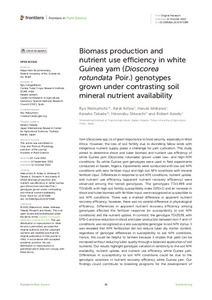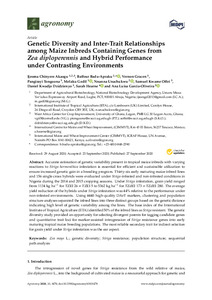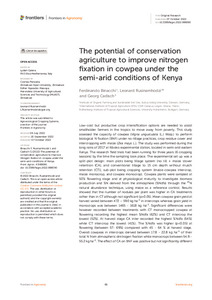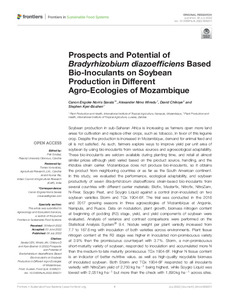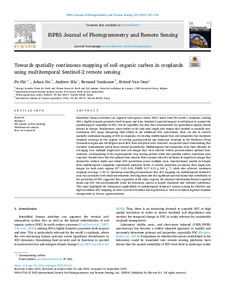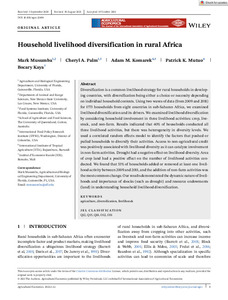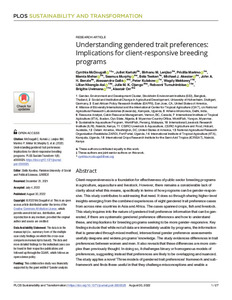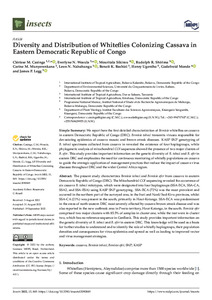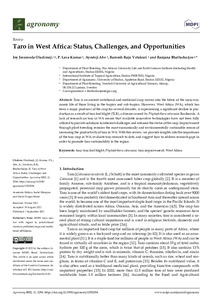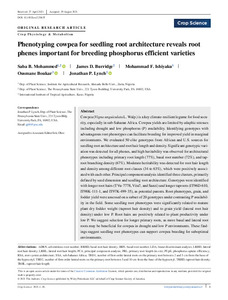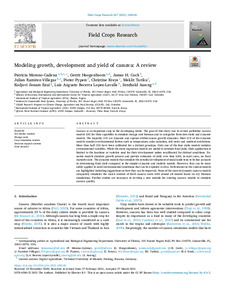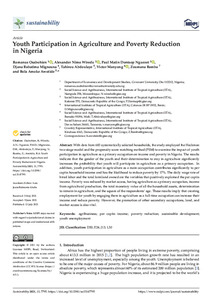Welcome to the International Institute of Tropical Agriculture Research Repository
Journal and Journal Articles: Recent submissions
Now showing items 401-420 of 5157
-
Residues from black soldier fly (Hermetia illucens) larvae rearing influence the plant-associated soil microbiome in the short term
(2022-09-26)The larvae of the black soldier fly (BSFL, Hermetia illucens) efficiently close resource cycles. Next to the nutrient-rich insect biomass used as animal feed, the residues from the process are promising plant fertilizers. Besides a high nutrient content, the residues contain a diverse microbial community and application to soil can potentially promote soil fertility and agricultural production through the introduction of beneficial microbes. This research assessed the application of the residues ... -
Re-assessing the pest status of Tetranychus evansi (Acari: Tetranychidae) on solanaceous crops and farmers control practices in Benin
(2022-12)This study was carried out 7 years after a first one conducted in 2013 as part of the policy of the Benin government to promote the vegetable production sector. Data collection was mostly based on a countrywide survey conducted in 25 municipalities throughout Benin, from August to December 2020. Farmers were selected based on their experience in cultivating solanaceous crops, and were interviewed to assess their perception about the severity of the spider mite Tetranychus evansi, the control method ... -
Biomass production and nutrient use efficiency in white Guinea yam (Dioscorea rotundata Poir.) genotypes grown under contrasting soil mineral nutrient availability
(2022)Yam (Dioscorea spp.) is of great importance to food security, especially in West Africa. However, the loss of soil fertility due to dwindling fallow lands with indigenous nutrient supply poses a challenge for yam cultivation. This study aimed to determine shoot and tuber biomass and nutrient use efficiency of white Guinea yam (Dioscorea rotundata) grown under low- and high-NPK conditions. Six white Guinea yam genotypes were used in field experiments conducted at Ibadan, Nigeria. Experiments were ... -
Genetic diversity and inter-trait relationships among maize inbreds containing genes from Zea diploperennis and hybrid performance under contrasting environments
(2020)Accurate estimation of genetic variability present in tropical maize inbreds with varying reactions to Strigahermonthica infestation is essential for efficient and sustainable utilization to ensure increased genetic gain in a breeding program. Thirty-six early maturing maize inbred lines and 156 single cross hybrids were evaluated under Striga-infested and non-infested conditions in Nigeria during the 2014 and 2015 cropping seasons. Under Striga infestation, grain yield ranged from 1134 kg ha−1 ... -
The potential of conservation agriculture to improve nitrogen fixation in cowpea under the semi-arid conditions of Kenya
(2022-10-07)Low-cost but productive crop intensification options are needed to assist smallholder farmers in the tropics to move away from poverty. This study assessed the capacity of cowpea (Vigna unguiculata (L.) Walp.) to perform biological N fixation (BNF) under no-tillage practices, crop residue cover and intercropping with maize (Zea mays L.). The study was performed during the long rains of 2017 at Kiboko experimental station, located in semi-arid eastern Kenya. The research field trials had been running ... -
Prospects and potential of bradyrhizobium diazoefficiens based bio-inoculants on soybean production in different agro-ecologies of Mozambique
(2022-07)Soybean production in sub-Saharan Africa is increasing as farmers open more land areas for cultivation and replace other crops, such as tobacco, in favor of this legume crop. Despite the production is increased in Mozambique, demand for animal feed and oil is not satisfied. As such, farmers explore ways to improve yield per unit area of soybean by using bio-inoculants from various sources and agroecological adaptability. These bio-inoculants are seldom available during planting time, and retail ... -
Towards spatially continuous mapping of soil organic carbon in croplands using multitemporal Sentinel-2 remote sensing
(2022-11)Intensified human activities can augment soil organic carbon (SOC) losses from the world’s croplands, making SOC a highly dynamic parameter both in space and time. Sentinel-2 spectral imagery is well placed to capture the spatiotemporal variability of SOC, but its capability has only been demonstrated for agricultural regions mostly located in Europe. Furthermore, most studies so far only used single-date images that resulted in spatially non-continuous SOC maps, hampering their ability to aid ... -
Suitability of testers to characterize provitamin a content and agronomic performance of tropical maize inbred lines
(2022)Vitamin A deficiency poses health risks for children, pregnant women, and nursing mothers in sub-Saharan Africa (SSA) and Southeast Asia. Provitamin A–biofortified maize varieties can contribute to minimizing the adverse effects of vitamin A deficiency in areas where maize is a staple food crop. Identifying suitable testers is important to breed provitamin A–biofortified hybrid maize. This study was therefore conducted to 1) assess the suitability of maize inbred lines with contrasting levels of ... -
Household livelihood diversification in rural Africa
(2022-03)Diversification is a common livelihood strategy for rural households in developing countries, with diversification being either a choice or necessity depending on individual household contexts. Using two waves of data (from 2009 and 2011) for 1773 households from eight countries in sub-Saharan Africa, we examined livelihood diversification and its drivers. We examined livelihood diversification by considering household involvement in three livelihood activities: crop, livestock, and non-farm. ... -
Genotype by environment interaction and grain yield stability of drought tolerant cowpea landraces in Ethiopia
(2022)Cowpea is one of the most important indigenous food and forage legumes in Africa. It serves as a primary source of protein for poor farmers in drought-prone areas of Ethiopia. The crop is used as a source of food, and insurance crop during the dry season. Cowpea is adaptable to a wide range of climatic conditions. Despite this, the yield of the crop is generally low due to lack of stable and drought-tolerant varieties. In this study, 25 cowpea genotypes were evaluated in five environments using a ... -
Understanding gendered trait preferences: implications for client-responsive breeding programs
(2022)Client-responsiveness is a foundation for effectiveness of public sector breeding programs in agriculture, aquaculture and livestock. However, there remains a considerable lack of clarity about what this means, specifically in terms of how programs can be gender-responsive. This study contributes to addressing that need. It does so through sharing higher-level insights emerging from the combined experiences of eight gendered trait preference cases from across nine countries in Asia and Africa. The ... -
Long-term evidence for ecological intensification as a pathway to sustainable agriculture
(2022-09)Ecological intensification (EI) could help return agriculture into a ‘safe operating space’ for humanity. Using a novel application of meta-analysis to data from 30 long-term experiments from Europe and Africa (comprising 25,565 yield records), we investigated how field-scale EI practices interact with each other, and with N fertilizer and tillage, in their effects on long-term crop yields. Here we confirmed that EI practices (specifically, increasing crop diversity and adding fertility crops and ... -
Diversity and distribution of whiteflies colonizing cassava in eastern Democratic Republic of Congo
(2022)The present study characterizes Bemisia tabaci and Bemisia afer from cassava in eastern Democratic Republic of Congo (DRC). The Mitochondrial COI sequencing revealed the occurrence of six cassava B. tabaci mitotypes, which were designated into four haplogroups (SSA-ECA, SSA-CA, SSA2, and SSA-ESA) using KASP SNP genotyping. SSA-ECA (72%) was the most prevalent and occurred in the northern part of the surveyed area, in the Ituri and Nord/Sud-Kivu provinces, whilst SSA-CA (21%) was present in the ... -
Adaptation strategies to climate change and impacts on household income and food security: evidence from Sahelian region of Niger
(2022-03-01)Sahelian countries, particularly Niger, are more vulnerable to climate change due to the high dependence of most of their populations on rain-fed agriculture and limited capacities to respond to climate variability and change. This paper examines the factors influencing climate change adaptation strategies and the impacts on household income and food security in rural Niger. For this purpose, we collected data from 1783 valid rural households in four main agricultural regions of Niger. The results ... -
Strategizing research and development investments in climate change adaptation for root, tuber and banana crops in the African Great Lakes Region: a spatial prioritisation and targeting framework
(2022-10-22)CONTEXT Given the significance of climate change impacts on farming communities, large investments are made by research and development actors, including farmers themselves, to adapt agricultural systems. A data-driven approach is required to guide these investments and maximize their impact. In the African Great Lakes Region (GLR), root, tuber and banana (RT&B) crops are a vital component of smallholder farming systems, but little is known about strategies to mitigate climate change impacts on ... -
Taro in west Africa: status, challenges, and opportunities
(2022-09-01)Taro is an ancient nutritional and medicinal crop woven into the fabric of the socio-economic life of those living in the tropics and sub-tropics. However, West Africa (WA), which has been a major producer of the crop for several decades, is experiencing a significant decline in production as a result of taro leaf blight (TLB), a disease caused by Phytophthora colocasiae Raciborski. A lack of research on taro in WA means that available innovative technologies have not been fully utilized to provide ... -
Phenotyping cowpea for seedling root architecture reveals root phenes important for breeding phosphorus efficient varieties
(2021)Cowpea (Vigna unguiculata L. Walp.) is a key climate-resilient legume for food security, especially in sub-Saharan Africa. Cowpea yields are limited by edaphic stresses including drought and low phosphorus (P) availability. Identifying genotypes with advantageous root phenotypes can facilitate breeding for improved yield in marginal environments. We evaluated 50 elite genotypes from African and U.S. sources for seedling root architecture and root hair length and density. Significant genotypic ... -
Modeling growth, development and yield of cassava: a review
(2021-06-15)Cassava is an important crop in the developing world. The goal of this study was to review published cassava models (18) for their capability to simulate storage root biomass and to categorize them into static and dynamic models. The majority (14) are dynamic and capture within season growth dynamics. Most (13) of the dynamic models consider environmental factors such as temperature, solar radiation, soil water and nutrient restrictions. More than half (10) have been calibrated for a distinct ... -
Youth participation in agriculture and poverty reduction in Nigeria
(2021)With data from 683 systematically selected households, the study employed the Heckman two-stage model and the propensity score matching method (PSM) to examine the impact of youth participation in agriculture as a primary occupation on income and poverty in Nigeria. The results indicate that the gender of the youth and their determination to stay in agriculture significantly increases the probability that youth will participate in agriculture as a primary occupation. In addition, youth participation ...



